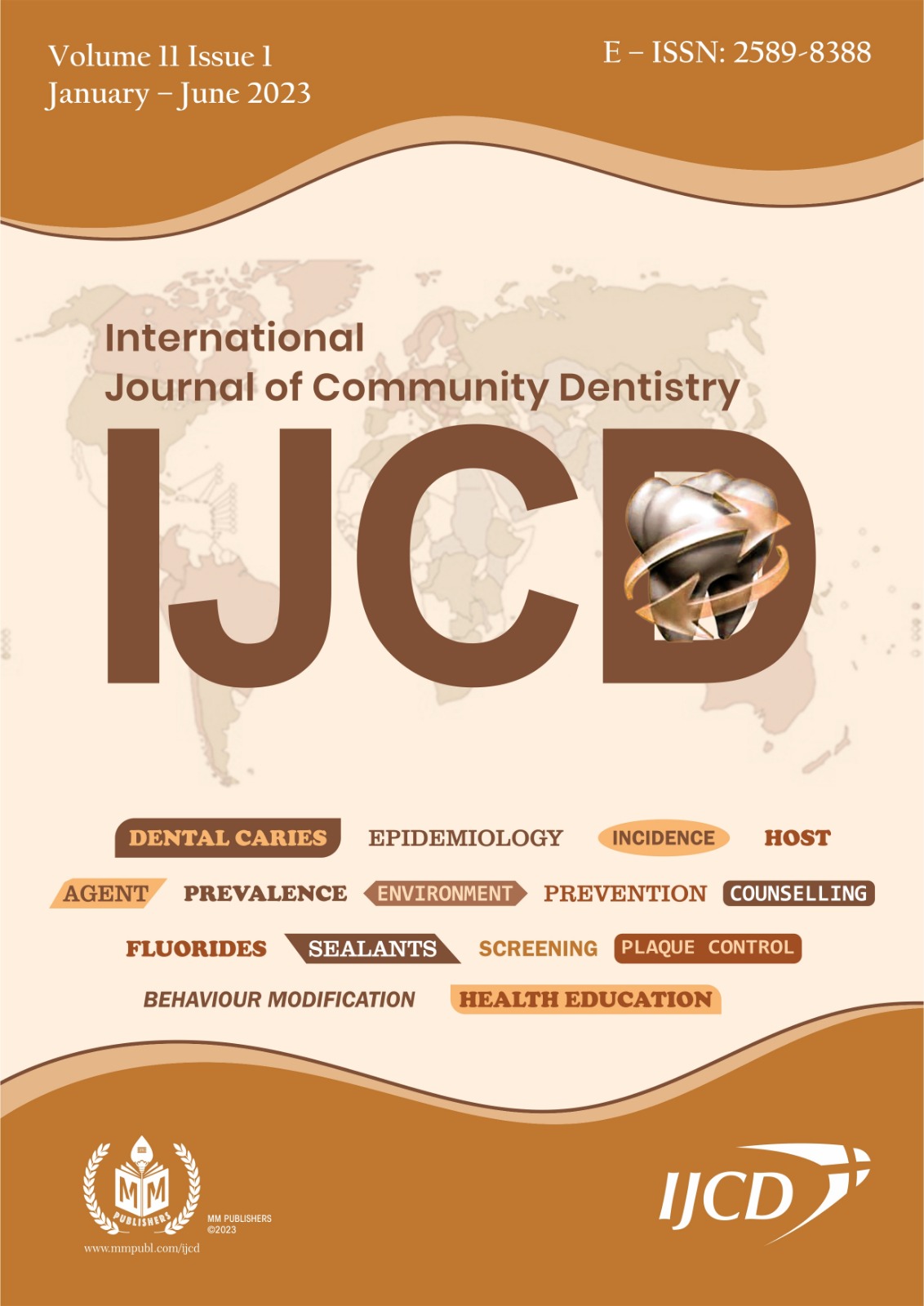In Vitro Analysis of Hydrophilic and Conventional sealants - A comparative study
Original Article
DOI:
https://doi.org/10.56501/intjcommunitydent.v11i1.792Keywords:
pit and fissure sealants, scanning electron microscope, resin tag, viscosityAbstract
Background: According to the World Health Organization, filling up the pits and fissures is one of the most efficient, least invasive ways to completely protect the occlusal surface from the carious phenomena. In vitro tests are essential for quickly delivering the knowledge required about the effectiveness of more recent sealant brands. Consequently, the objective of the current study was to assess and contrast the viscosity and length of resin tags on permanent molars of conventional and hydrophilic sealants.
Materials and Methods: Twenty extracted third molars were split into two groups at random, one receiving conventional sealant (Clinpro 3M ESPE), and the other receiving hydrophilic sealant (UltraSeal XT Hydro). Each tooth's occlusal surfaces underwent an acid etchant pretreatment before the appropriate sealants were applied. Afterwards thermocycling and longitudinal sectioning were applied to both groups. For the purpose of measuring the length of the resin tag, the sectioned tooth specimens were examined under a scanning electron microscope. An Anton Paar viscometer was used to measure viscosities. The difference between the mean resin tag length of Group I and Group II sealants was compared using an independent t-test.
Results: The mean resin tag length of Group II (10.07+/- 1.01m) was found to be higher than Group I (7.49+/- 0.94m), and this difference was statistically significant (P = 0.001). The viscosity measurements of Groups I and II were determined to be 0.8 mega Pascal (MPa) and 0.6 MPa, respectively.
Conclusion: Based on the findings of the current investigation, it can be said that Group II sealants generated resin tags of sufficient length and had lower viscosities than Group I sealants. Thus, a hydrophilic sealant outperformed a conventional sealant in terms of performance.
References
Bekes K. Pit and Fissure Sealants. Springer; 2018. 179 p.
Beslot-Neveu A, Courson F, Ruse ND. Physico-chemical approach to pit and fissure sealant infiltration and spreading mechanisms. Pediatr Dent. 2012 May-Jun;34(3):57–61.
Beun S, Bailly C, Devaux J, Leloup G. Physical, mechanical and rheological characterization of resin-based pit and fissure sealants compared to flowable resin composites. Dent Mater. 2012 Apr;28(4):349–59.
Ahovuo-Saloranta A, Forss H, Hiiri A, Nordblad A, Mäkelä M. Pit and fissure sealants versus fluoride varnishes for preventing dental decay in the permanent teeth of children and adolescents. Cochrane Database Syst Rev. 2016 Jan 18;2016(1):CD003067.
Lam PPY, Sardana D, Ekambaram M, Lee GHM, Yiu CKY. Effectiveness of Pit and Fissure Sealants for Preventing and Arresting Occlusal Caries in Primary Molars: A Systematic Review and Meta-Analysis. J Evid Based Dent Pract. 2020 Jun;20(2):101404.
Schwendicke F, Frencken J, Innes N. Caries Excavation: Evolution of Treating Cavitated Carious Lesions. Karger Medical and Scientific Publishers; 2018. 176 p.
Beauchamp J, Caufield PW, Crall JJ, Donly K, Feigal R, Gooch B, et al. Evidence-based clinical recommendations for the use of pit-and-fissure sealants: a report of the American Dental Association Council on Scientific Affairs. J Am Dent Assoc. 2008 Mar;139(3):257–68.
Singh R, Lakhanam M. An In Vitro Study of Three Types of Pit and Fissure Sealants for Viscosity, Resin Tag, and Microleakage: A Scanning Electron Microscope Study. Int J Clin Pediatr Dent. 2022 May-Jun;15(3):304-310. doi: 10.5005/jp-journals-10005-2392. PMID: 35991789; PMCID: PMC9357544.
Rafatjou R, Nobahar S, Nikfar M, et al. Retention and effectiveness of dental sealant after twelve months in Iranian children. Avicenna J Dent Res. 2013;5(2):1–5. doi: 10.17795/ajdr-20577.
Bakhshandeh A, Qvist V, Ekstrand FR. Sealing occlusal caries lesions in adult referred for restorative treatment: 2–3 years of follow up. Clin Oral Investig. 2011;16(2):521–552. doi: 10.1007/s00784-011-0549-4.
Bhosale GS. Mechanical and Physical Properties of Filled, Unfilled and Fluoride Releasing Pit and Fissure Sealants. 1997. 132 p.
Prabhakar A, Dahake PT, Raju O, Basappa N. Fluoride: Is It Worth to be added in Pit and Fissure Sealants? Int J Clin Pediatr Dent. 2012 Jan;5(1):1–5.
Paglia L, Ferrazzano G, Beretta M. The Role of Pit and Fissure Sealants in the Prevention of Dental Caries [Internet]. Pit and Fissure Sealants. 2018. p. 35–50. Available from: http://dx.doi.org/10.1007/978-3-319-71979-5_4
S J, JenniferSuhasini S, IJAR, Shanmugaavel AK. Fluoride releasing and colourchanging pit and fissure sealants – a review. Vol. 5, International Journal of Advanced Research. 2017. p. 2212–4. Available from: http://dx.doi.org/10.21474/ijar01/3743
Simonsen RJ, Neal RC. A review of the clinical application and performance of pit and fissure sealants. Vol. 56, Australian Dental Journal. 2011. p. 45–58. Available from: http://dx.doi.org/10.1111/j.1834-7819.2010.01295.x
Prabhakar AR, Murthy S, Sugandhan S. Comparative evaluation of the length of resin tags, viscosity and microleakage of pit and fissure sealants - an in vitro scanning electron microscope study. Vol. 2, Contemporary Clinical Dentistry. 2011. p. 324. Available from: http://dx.doi.org/10.4103/0976-237x.91797
Barnes DM, Kihn P, von Fraunhofer JA, Elsabach A. Flow characteristics and sealing ability of fissure sealants. Oper Dent. 2000 Jul-Aug;25(4):306–10.

Downloads
Published
How to Cite
Issue
Section
License
Copyright (c) 2023 Mathusudhanan K, Mahalakshmi K

This work is licensed under a Creative Commons Attribution-NonCommercial 4.0 International License.



